15 Best Sauces To Pair With Desserts
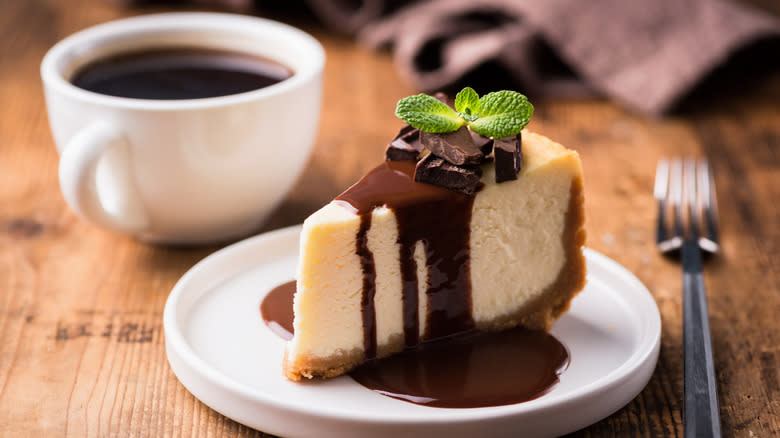
The phrase "save room for dessert" isn't an option in our household. But on their own, most desserts tend to taste a little... unfinished. After all, pasta gets a sauce, and steaks get a glaze, so why shouldn't desserts get their own sauce, too?
Lucky for sweet lovers, there is an entire array of sauces designed to enhance desserts. A short stroll down the ice cream aisle of your local grocery store will reveal a plethora of bottled and jarred sauces in almost every flavor and texture, from decadent hot fudge to the inconspicuous jar of wet nuts. There are even sauces that you'll have to make yourself (or sample them at a restaurant, of course) to try them. But these sauces aren't just for ice cream; they can be used for different types of cakes, pies, and seemingly every sweet treat in between.
We've curated a guide to some of the most popular dessert sauces and the best ways to pair them with sweet classics. We looked at several different factors, including the sauce's texture and consistency, and paired them with the gaps we found in popular desserts, such as a need for something fruity, complex, or nutty.
Read more: 30 Types Of Cake, Explained
Butterscotch Sauce
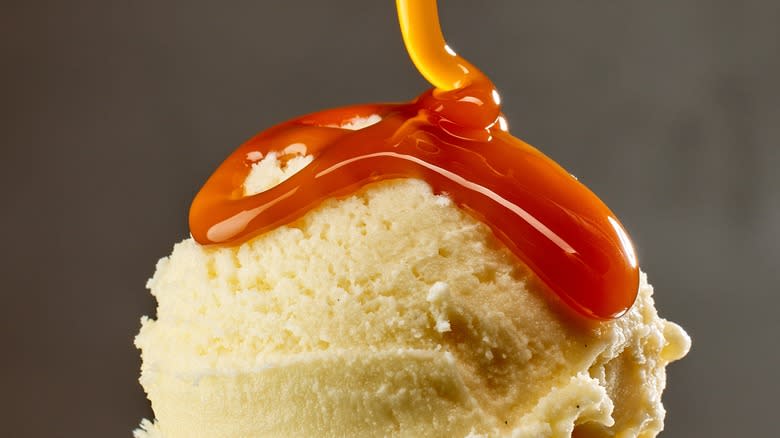
Butterscotch may not be a dessert syrup that you have ever sampled because it's often overshadowed by caramel. The key difference that sets butterscotch apart is that it's made with dark brown sugar rather than white, granulated sugar, as is the case with caramel. The darker sugar alters the sauce's color and gives it sweeter undertones while retaining a toffee flavor.
The sheer sweetness and viscosity of this dessert sauce can make pairing it with other sweet things difficult. But there are some options for using this sauce in your dessert routine. You can drizzle butterscotch on pumpkin pie to add extra sweetness and toffee flavors that will complement the squash well. We prefer using it over caramel because the brown sugar adds more molasses undertones, which complement the spices in the pie better than caramel. You can also upgrade your pecan pie with the warm flavors of butterscotch in the form of chips -- but just beware that a little bit of butterscotch flavor can quickly make your dessert too sweet.
Caramel Sauce
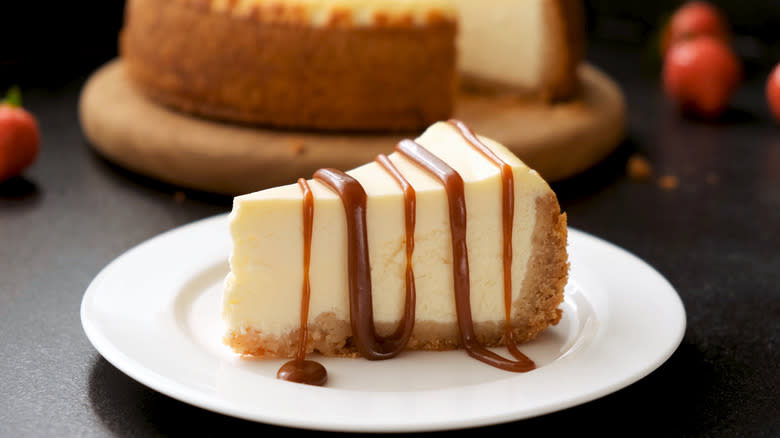
Caramel sauce is a must-have for dessert lovers. It's thick and goopy, and it conveniently comes in a jar, so you'll never have to worry about standing over a stove and making it yourself. There are tons of delicious uses for canned caramel sauce that incorporate an array of ingredients and flavors. You can add a swirl of the sauce to your brownie batter before popping it in the oven for a marbled effect and to add an extra sticky component. Or, stir caramel sauce into your Rice Krispies treats to make an adult-ish take on a childhood classic.
Besides adding it to desserts as part of the preparation steps, you can also drizzle the sauce on top of some of your already-baked favorites. Cheesecake is a classic one that comes to mind; the sweet caramel will pair well with a tangy filling and a buttery graham cracker crust. Plain cheesecake will allow your tastebuds to hone in on the flavor of the caramel, but we could also see how you could use it for a spiced cheesecake or a chocolate cheesecake, too.
Hot Fudge
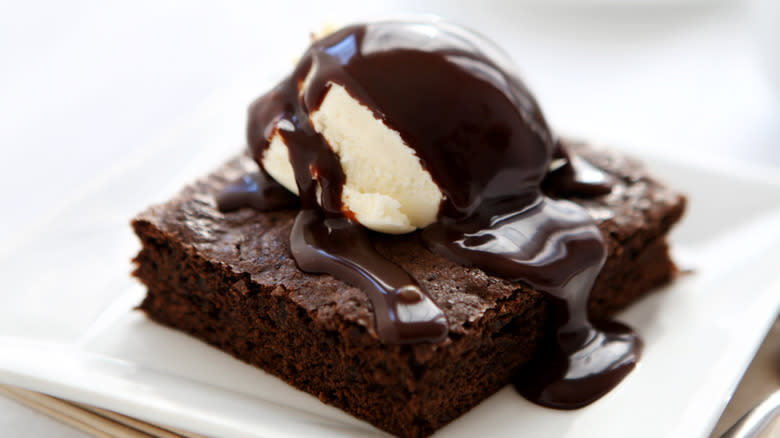
There is one pairing that immediately comes to mind for hot fudge: ice cream. After all, who doesn't love watching their cold ice cream slowly melt after it's been covered in a spoonful of hot, thick chocolate sauce? But the reality is that there are many other desserts, besides ice cream sundaes, that can benefit from this unique dessert sauce.
The one thing to know about hot fudge is that it's thick. It won't slide off your spoon easily like a thin chocolate syrup and instead has darker, more brownie-like flavors. Try making a hot fudge sundae cake by topping your chocolate sponge cake with a layer of this thick condiment. It will easily transform your cake into a denser treat. You can also pair it with a crepe, which is light enough in flavor and texture that it will allow your hot fudge to shine. Alternatively, you may also try making your hot fudge into a dip by whipping it up with cream cheese and serving it with a side of cookies or fruit.
Chocolate Syrup
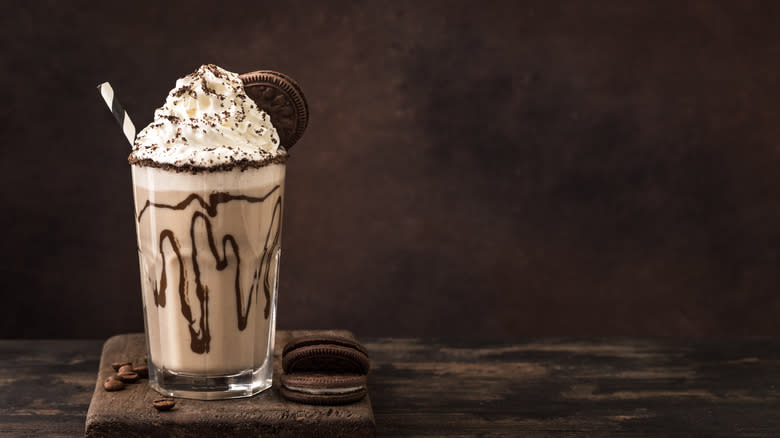
Chocolate syrup is not as thick as chocolate sauce or decadent hot fudge, but it can still hold its weight in your home kitchen. Its liquidness makes it ideal for swirling into other things, such as a milkshake or a New York egg cream. Alternatively, you can also stick to a classic pairing for chocolate syrup: ice cream.
Chocolate syrup is best paired with ice cream because the flavors of the syrup aren't overwhelmingly chocolatey. Think of the cheap Hershey's syrup of your childhood -- it didn't really taste like chocolate, did it? Instead, it has confectionary cocoa undertones that lean sweet more than anything, which means it will easily take a backseat to whatever flavors you pair it with. Stick with a plain Jane vanilla soft serve (just don't forget the rainbow sprinkles), or pair the chocolate ice cream with complementary flavors like peanut butter. It's a nostalgic sauce that's relatively easy to integrate into your dessert routine.
Magic Shell
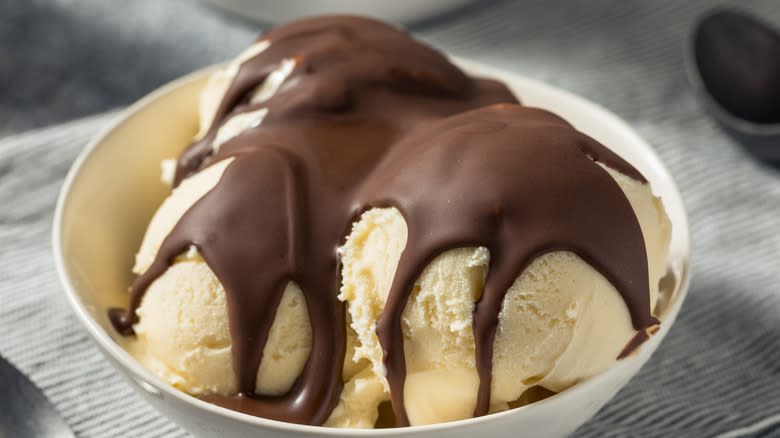
Magic shell is probably one of the most child-friendly dessert sauces. It's often made by combining chocolate with saturated fat, like coconut oil, so that the mixture drips into the dessert as a liquid and hardens as a solid. As a result, you can easily push your spoon into the shell and watch it shatter into small pieces around it. It's really satisfying to watch -- and even more fun to eat.
Although milk chocolate is a common flavor for this shell, you can replace it with other types of chocolate or even buy pre-made bottles of non-chocolate magic shell from brands like Smucker's. Granted, this sauce is much more limited in application than other dessert sauces we looked at. It must be poured on something cold; otherwise, it won't set. So that leaves ice cream (or other similar frozen desserts like gelato and potentially sorbets) as one of your only options for how to put this sauce to use in your kitchen.
Créme Anglaise
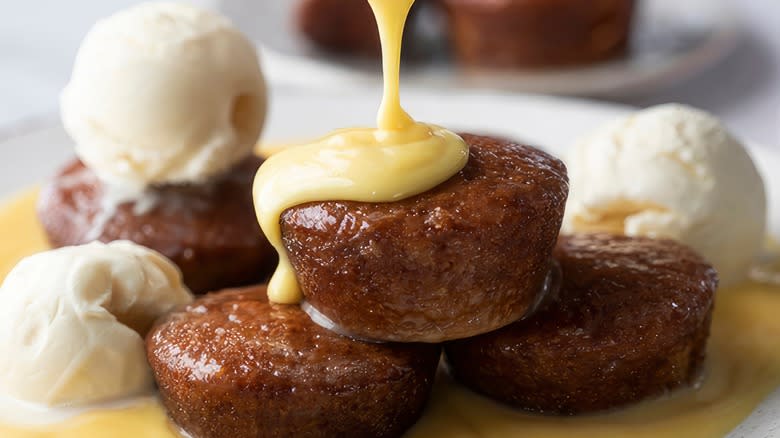
Crème anglaise is a dessert sauce that we strongly believe everyone should be able to make at home. It's essentially a sweetened vanilla custard cooked just enough to be easily poured onto desserts. When you see créme anglaise on the menu, it will likely only come in one flavor: vanilla. Although this profile might seem limiting and rather basic, it actually gives you a ton of room to play around with when it comes to pairings.
You can easily drizzle this sweetened custard over your apple or fruit pies to help balance out some of the tartness. It also makes a great pairing for cakes or baked puddings because it will act like melted ice cream. In fact, Ina Garten uses melted ice cream as a simple replacement for créme anglaise -- which is something we recommend if you're short on time or need something to drizzle on your bowl of fresh summer berries.
Fruit Sauce
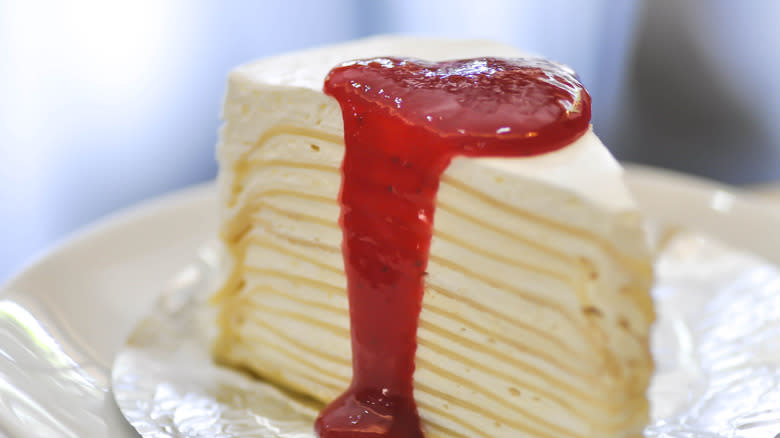
Fruit sauces are an easy way to infuse chipper springtime flavors into your favorite desserts. It's important to note here that sauces are different than coulis because the former is often left chunky, with small flecks of seeds and pulp. So, when you're figuring out how to pair this sauce with desserts, you'll need to be aware of how the dessert's texture might change when bits of fruit flesh float around in it.
Another key difference is that sauce typically isn't as thick as coulis so that it will drip down into your dessert. For example, you can take your sponge cake to a new level by coating it with a drizzle of fruit sauce -- preferably a raspberry or strawberry sauce. The cake itself will soak in the juice while the bits of berry will provide a refreshing reprieve from the monotonous vanilla profile. You can also add a bit of sauce to your milkshake or frappé, or use this sauce as a layer in your summery trifle.
Peanut Butter Sauce
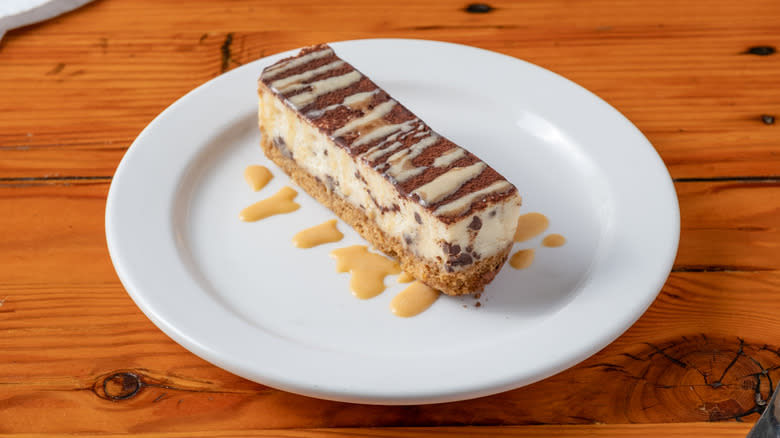
Peanut butter sauce is one of those dessert toppings that harnesses savory flavors more than sweet ones. It's more complex than a berry coulis or chocolate syrup -- which otherwise shift the entire dish into a place of overwhelming sweetness. That being said, you can make a smoother peanut butter sauce by adding a liquid sweetener, like honey, corn syrup, or maple syrup, to help your sauce spread out and cover your entire dessert. It can also help resolve the issue of peanut butter sauce always coming out too rich.
Peanut butter and chocolate are a natural pairing, which is why this nutty topping is a perfect fit for something like a decadent chocolate cheesecake. You can also add a drizzle of peanut butter sauce to your bundt cakes for a color contrast or add a swirl to your brownies to help switch things up. Peanut butter and banana are also a great pairing, so you could go down a rabbit hole and pour some on your banana cream pie or banana cake.
Walnuts In Syrup
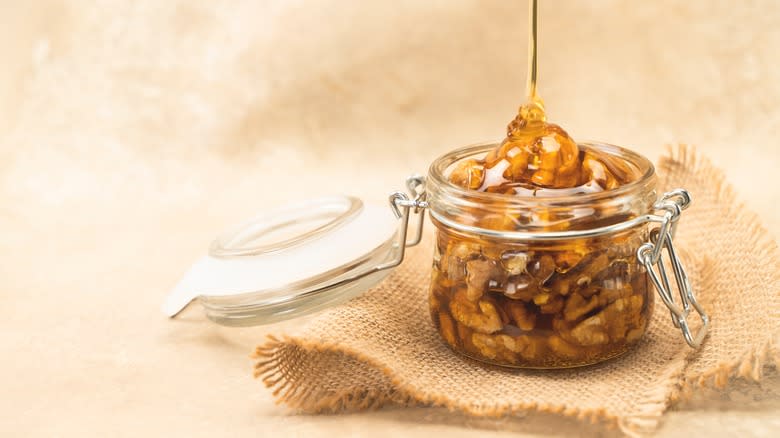
Walnuts in syrup (or "wet nuts," as we called them), were a staple in our pantry growing up, and we were surprised to learn that not many people actually still use this condiment today. This sugary spread, otherwise called "wet walnuts," is essentially just walnut pieces suspended in corn syrup. It's definitely a topping you want to enjoy in moderation, as eating corn syrup straight from a jar -- even if there are chunky pieces in it -- is not ideal, even if you love sweets.
Wet walnuts are a great complement to ice cream because the syrup tempers the walnuts' flavor and texture. You don't get as pronounced a bite as you would if you used a bag of fresh walnuts, which meshes well with the softness of the frozen dessert. You can also use wet nuts wherever you find walnuts in (or on) baked desserts. For example, try smothering your brownie or chocolate chip cookies in this condiment.
Since wet nuts lean sweet more than anything, it could also be a good pairing for a tangy cheesecake. The walnuts will complement the buttery graham cracker crust, while the syrup will sweeten the filling.
Zabaglione
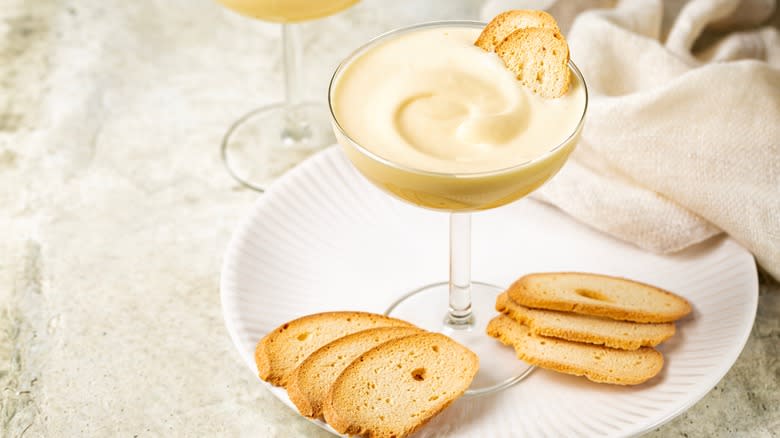
You may not associate that bottle of marsala cooking wine with dessert, but it might be about time to. Zabaglione is an Italian custard that puts this ingredient center stage. Although its name suggests something very high-class and elegant, it's relatively simple for a home cook to make. The base combines egg yolks, sugar, and kosher salt — as well as the booze. The result is a brown-sugar-like flavor with subtle hints of licorice, tamarind, and apricot.
Keeping the custard's flavor front and center is the key to pairing this dessert sauce with your favorite treats. Berries are a natural addition; you can even just serve a small bowl of this custard with a smattering of strawberries, blueberries, and blackberries for a simple, summery dessert. Or, you might enjoy dipping sweet biscuits into it to soak up all of that marsala flavor and appreciate the Italian edge this sauce brings to the table.
Sugar Glaze
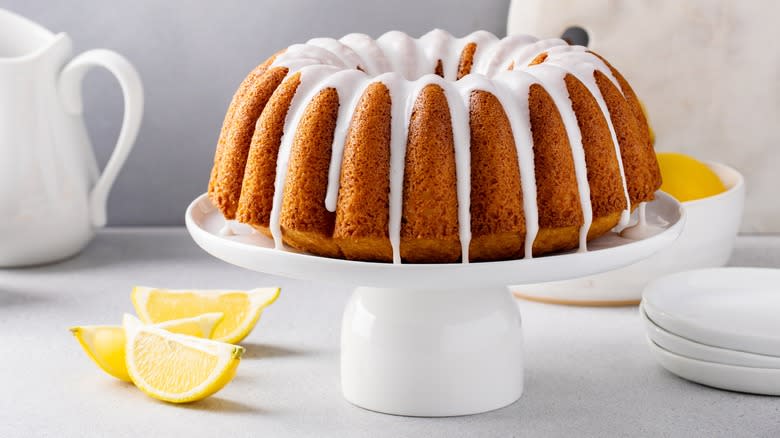
A plain sugar glaze is the definition of "don't work too hard." The key to using this type of sauce for your baked treats is that you only need to add it to desserts where it's really warranted. Your chocolate chip cookies, brimming with brown sugar and chocolate chips, don't need a sugar glaze. But a dainty lemon poppyseed cake with a tooth-puckeringly sour flavor could really use a bit of reprieve with the help of a glaze.
You can tweak the ratio of your ingredients in your icing to make something that shatters or work with something that says gooey and liquid instead. You can make a simple powdered sugar glaze for your baked goods by mixing together a bit of sifted sugar and milk (or some non-dairy substitute). Glaze tends to harden on cold desserts faster than warm ones, so we recommend adequately chilling your baked goods if you're looking for something that stays perched on your bundt cake instead of absorbing straight into the sponge.
Ganache
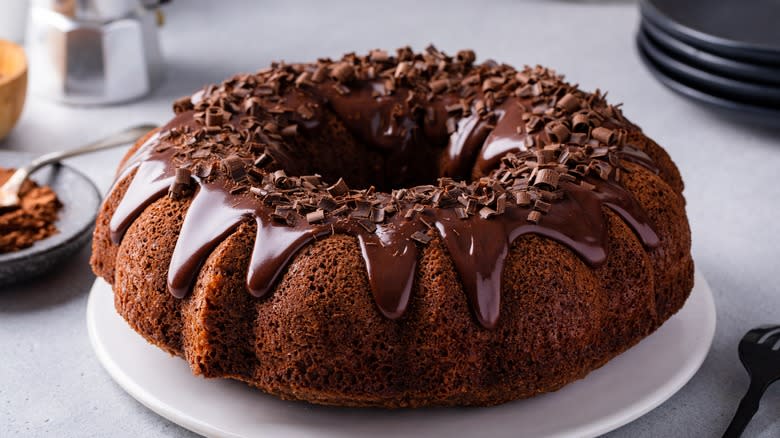
Ganache -- what's not to love? Although this topping walks a thin tightrope between the line of frosting and sauce, we thought we would include it on this list anyway because it can be used to enhance the flavor of so many different types of desserts. In general, ganache is made by mixing equal parts dairy (like milk or cream) and chocolate, while chocolate sauce is made with more sweeteners and water -- which causes it to come out thinner. As a result, ganache is more mature and chocolate-forward, which is why you really shouldn't skimp out and use cheap chocolate to make it.
Your ganache will go hand in hand with your favorite cake. The visual appeal of drizzling it on the edge of your frosting or adding it as a dollop to your cupcakes will make you seem like quite the dessert-making professional. While you could smother your ice cream in ganache or drizzle some on your brownies, it won't give you the same aesthetic value as deliberately using it as a decorating tool.
Fruit Coulis
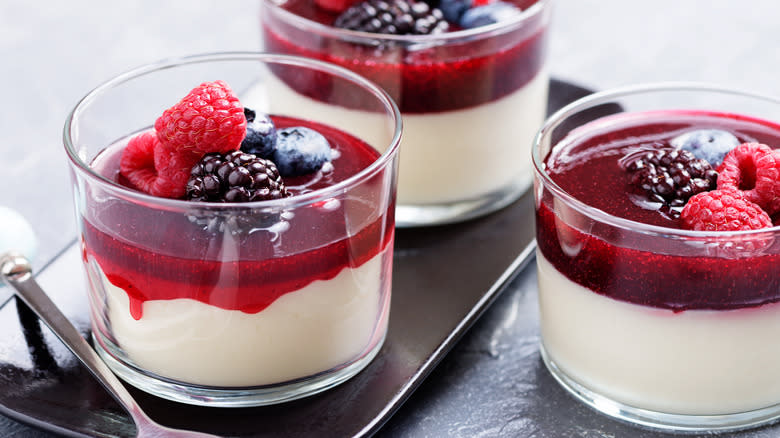
Fruit coulis shares some similarities with fruit sauce, but it takes on a more jelly-like texture because it's puréed, strained, and often thickened with cornstarch. This makes it easy to add your coulis to a layered dessert, like a pudding, without worrying about your layers interspersing. It's also often made with berries, so it's a simple way to hone in on organic, sweet flavors that will take your dessert to a new level.
That's not to say that you can't take a less refined approach to using this dessert sauce in the kitchen. If you like a clear distinction between your ice cream and your toppings, use it in place of fruit sauce or syrup in your next sundae recipe. Or, dress up a basic cheesecake with a layer of coulis on top.
If you have experience working with meringues, you might even try to add your coulis to your towering pavlova. Start with a plain recipe, or channel the flavors of the Black Forest with a cherry coulis and chocolate pavolva.
Curd
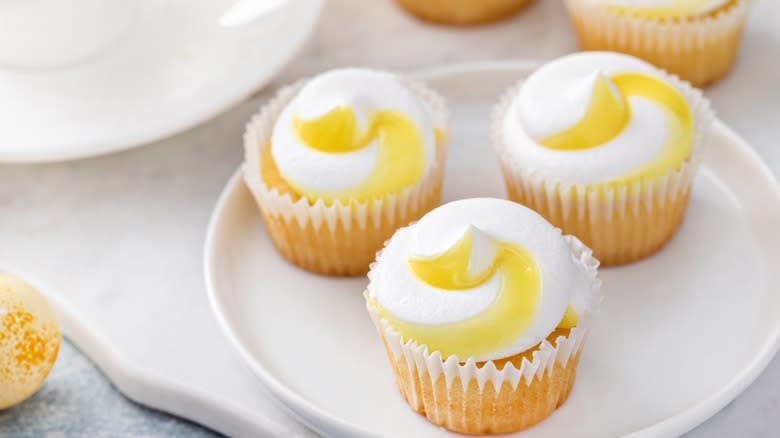
Curd is the perfect dessert sauce for those looking to add an acidic flair to their favorite desserts. It's essentially a custard flavored with an acidic element, like lemon or passionfruit, that has been cooked down until thick. The main difference between a curd and a custard is that curd can be quite sour because it's made with ingredients like lemon juice. If you're not careful with how you use it, you could end up shifting the entire balance in a direction that you wouldn't expect.
Curd is an excellent pairing with other light and fluffy desserts, like meringues. The flavor isn't muddled too much since the only element the curd has to compete with is the sweetness of the sugar. It can also be used sparingly on vanilla cakes, especially those iced with tall, fluffy meringue-based or whipped cream frostings. For something a bit more portable, try sandwiching a thin layer of curd in your cookie bars.
Chocolate Sauce
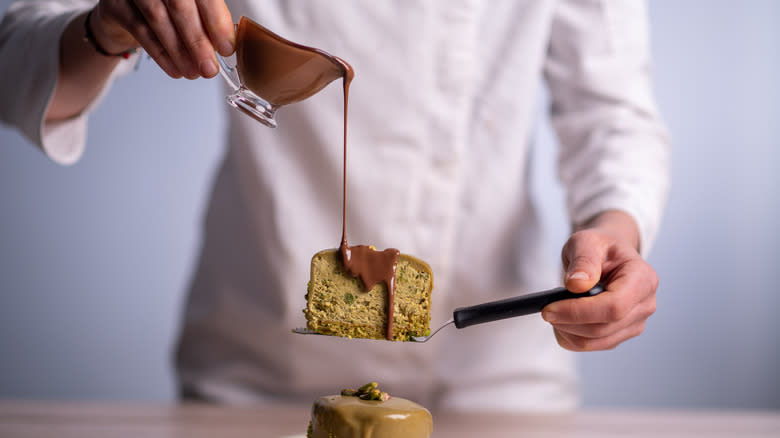
Chocolate sauce is essentially Goldilocks of chocolate dessert sauces. It doesn't have the same density and depth as ganache or hot fudge, but it is much thicker and easier to spread on desserts than chocolate syrup. Besides the variation in consistency, another thing that sets chocolate sauce apart from syrup is that it's made with milk or cream rather than water, which gives it a more buttery, fatty flavor.
There are a ton of different dessert pairings that work well with the texture and flavor of chocolate sauce. One of the best ones is cream puffs. The fluffy choux pastry and the decadent vanilla filling really pop with a drizzle of chocolate sauce, which will harden slightly once the dessert is chilled. You can also pour this sauce on your baked puddings or lava cakes to add an extra chocolatey element. Chocolate sauce doesn't have the same overwhelming richness as ganache or whipped frosting, making it ideal for garnishing your treats before you serve them.
Read the original article on Tasting Table

